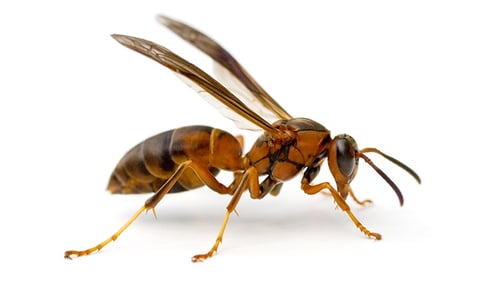Closer Look with Heather Patterson, Technical Services Manager

Stinging insects have a bad rap (and for a good reason). Each year in the United States, thousands of people are sent to the emergency room following insect stings, and as many as 90-100 people die from the allergic reactions. Because of this, most people will give bees, wasps, and hornets a wide berth. Even still, there are plenty of unique and unusual reasons to appreciate these creatures from afar.
Unlike vespids (hornets, wasps, and yellow jackets), bees have a barbed stinger which will often remain in the skin after a sting. Additionally, the bee’s venom sac will usually stay attached to continually pump venom through the barbed stinger. The quicker it can be removed, the better. Though the loss of her stinger and venom sac will result in the worker bee’s death, it’s a sacrifice she made to protect the hive.
A recent publication on brood reduction in Isodontia harmandi wasp larvae revealed that sibling cannibalism was to blame. Female wasps create communal brood cells for her developing offspring and provides them parasitized prey for nutrition. When available prey resources are depleted, hungry larvae will gobble up a nearby brother or sister as their next meal. In I. harmandi wasp brood cells, not all larvae will not make it out alive.
Wasps are important pollinators, too. Their unpopular reputations can overshadow their impact, but wasps pollinate many flowering plants and crops we enjoy. Additionally, they are predators of pesky garden pests, ecosystem indicators, and have been observed to disperse seeds and play a role in nutrient recycling via carrion decomposition. Wasps, arguably, deserve a bit more appreciation.
Velvet ants, sometimes called cow killers, have a misleading name. Though they are covered in velvety “hair”, or setae, female velvet ants are actually wingless, solitary wasps. Unlike true ants, velvet ants lack a petiole node, and have straight instead of elbowed antennae.
When food is scarce and plants have not yet bloomed, bumblebees have found a way to trigger plants to flower early. In a 2020 study, scientists observed that by biting and damaging the leaves of flowering plants, bumblebees can accelerate the flowering process. Timing of bee emergence from winter diapause is important for maintaining synchronization with blooming plants. This study demonstrates adaptability in pollinator systems and the bumblebee’s ability to impact resource availability.
Subscribe to our website and follow us on Facebook & Twitter for promotions, product launches, product info and much more!
References
Imasaki, T., & Endo, T. (2022). Brood reduction caused by sibling cannibalism in Isodontia harmandi (Hymenoptera: Sphecidae), a solitary wasp species building communal brood cells. PLoS One 17(5): e0267958. https://doi.org/ 10.1371/journal.pone.0267958
Pashalidou, F. G., Peybernesmark, T., Mescher, C., & De Moraes C.M. (2020). Bumble bees damage plant leaves and accelerate flower production when pollen is scarce. Science, 368(6493), 881-884. DOI: 10.1126/science.aay0496
Brock, R.E., Cini, A. & Sumner, S. (2021), Ecosystem services provided by aculeate wasps. Biol Rev, 96: 1645-1675. https://doi.org/10.1111/brv.12719
Arif, F. & Williams, M. Hymenoptera Stings. [Updated 2022 Mar 9]. In: StatPearls [Internet]. Treasure Island (FL): StatPearls Publishing. https://www.ncbi.nlm.nih.gov/books/NBK518972/
The Difference Between Paper Wasps and European Hornets (PestWorld.org): https://www.pestworld.org/news-hub/pest-articles/the-difference-between-paper-wasps-and-european-hornets/
Stinging Insects (PestWorld.org): https://www.pestworld.org/pest-guide/stinging-insects/
Insects and Scorpions (CDC.gov): https://www.cdc.gov/niosh/topics/insects/default.html
Featured Creature: European Honey Bee: https://entnemdept.ufl.edu/creatures/MISC/BEES/euro_honey_bee.htm